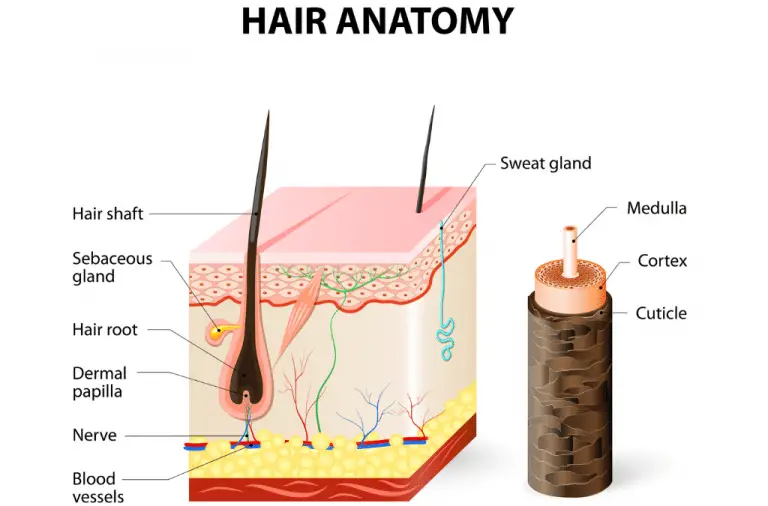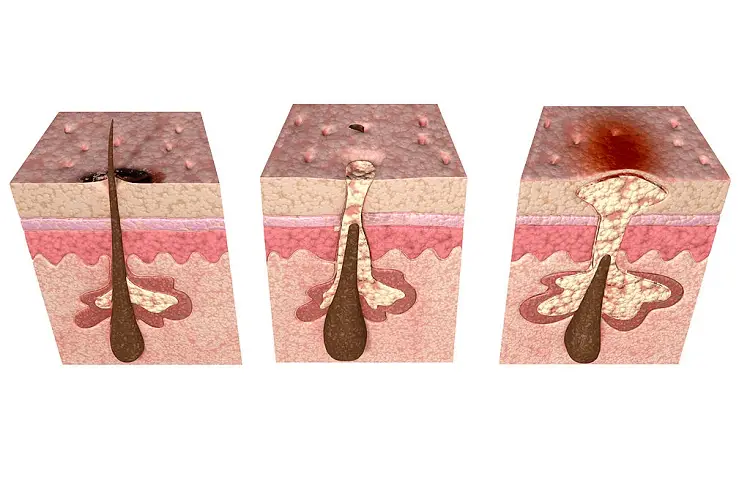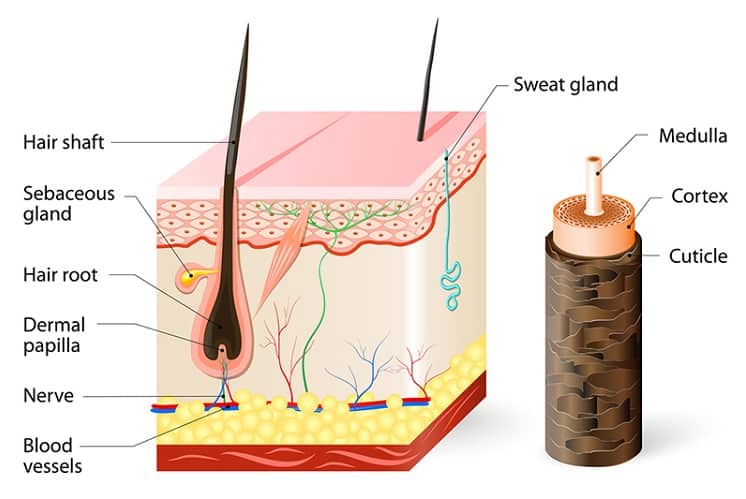
Page Contents
Do you want to grow long, soft, full, healthy hair?
If the answer is yes, then you must take some time to learn about your hair cuticles. Although this might sound odd, understanding your hair cuticles is crucial to growing healthy, natural hair successfully! Not only will you be proud of your hair, but your friends and colleagues will envy your luscious locks.
As Dr. Neil Persadsingh, a renowned hair scientist, puts it:
In this article, you’ll learn about the hair cuticle and how to prevent any damage. Most important, you will learn how to open and close the hair cuticle. Although it might not make sense now, this will be crucial to understand shortly.
Let’s get started by taking a look at our hair structure.
The Hair Structure

There are three layers to the hair:
- Medulla—innermost layer of the hair.
- Cortex—between the cuticle and the medulla.
- Cuticle—the outermost layer of the hair.
What Is The Hair Cuticle?
Since the cuticle is the outermost layer of hair, it is often regarded as the most important later. This protective layer holds the hair shaft on the follicle using a velcro bond.
The cuticle determines how well your hair styles and its texture. Perhaps most importantly, the cuticle allows moisture to pass into the hair shaft and stay there; although the cuticle does this naturally, a change in weather and chemical alterations can affect the process.
Functions of the Hair Cuticle
The cuticle protects the ‘brain’ of your hair: the cortex. The cortex tells the hair strand what to do, from its color, texture and curl pattern to thickness.
Additionally, the cuticle helps prevent damage to the cortex. When the cortex is damaged, the hair strand cannot repair itself.
Chemical treatments are effective because they go inside the hair strand, passing through the cuticle layer, and reform the cortex.
How the Cuticle Layer of the Hair Works

The cuticle layer consists of a protein called keratin scales, which either opens to receive an ingredient or closes to lock in the ingredient.
When the fibers of the cuticle open, your hair can absorb conditioning treatments or oils. When it closes, the cuticle locks in moisture and acts as a shield against damaging environmental factors.
If your cuticle is strong and healthy, your hair will also be strong and healthy.
How to Make Hair Cuticle Work for You
Your hair cuticles directly affect how your hair looks and feels, all due to moisture. If it was possible to manipulate your hair’s cuticles, you could control your hair’s appearance (e.g., curly, straight, wavy, etcetera).
If your hair is dry and breaks easily, your cuticles are most likely open. As a result, your hair’s moister has evaporated into the air.
On the other hand, if your hair is soft and shiny, your hair cuticles are most likely closed and saturated with moisture.
When your hair cuticles are closed, you are ensuring that your hair is moisturized 24/7. Closing your cuticles is the most effective ways to moisturize your hair and prevent constant dryness.
Causes of Hair Cuticle Damage
It is surprisingly easy to damage your hair cuticles, especially when you enjoy styling and redoing your hair. Once you destroy the cuticle, it is harder to grow your hair and experience long locks.
Hair porosity is your hair’s ability to retain moisture. If your hair has high porosity, it has a more challenging time retaining moisture. On the other hand, if it has low porosity, it doesn’t allow any moisture into the hair. It is best to strive for a middle ground with hair porosity.
Let’s take a look at some routines that can damage your hair’s cuticle.
Bleaching and hair coloring
Chemicals in bleach or hair dye can have negative effects on your hair’s cuticles. When you bleach your hair, the cuticles open up completely to remove the pigment. Afterward, they cannot close all the way, which leaves your hair weaker and prone to split ends.
Over-styling hair
Heat and chemicals can change your hair’s structure; in fact, your hair shaft’s cuticle can get damaged and begin to fray! Not only does heat open up your cuticle, but it dries up any moisture left in your hair.
Over shampooing
We shampoo our hair daily to cleanse and remove excess oil from the scalp, but it is possible to overdo it! Shampoo can strip natural oils away from the scalp, making your hair dry and easily damaged.
How to Open the Hair Cuticles

The only time you should want to open your cuticles is during a deep conditioning treatment. Once your cuticles are open, the moister will saturate your hair and lock in the shine.
Try applying coconut oil before washing your hair; it will make your cuticles smooth and allow for easy saturation. You can also let your conditioner to rest on your hair and fully absorb.
Although heat is looked down upon, you could use warm water to open your cuticles before hydration. Once conditioned, rinse your hair out with cold water.
If you have access to a salon, you can apply your condition then sit under a hooded dryer for a few minutes; This will guarantee your moisture is locked in.
How to Seal the Cuticles
Once of the best ways to lock in moisture is through sealing the cuticles; here are a few ways to do that:
Use cold water
Once your conditioner is applied, wash your hair out with cold water. Not only does this close your cuticles, but it helps reduce frizz and improves shine.
Use the PH balance
Balancing your pH levels are crucial. Human hair sits typically at a pH level of 5. At this level, your cuticles remain closed. Some hair products have different pH levels, which can affect your hair directly.
Shampoo, for example, and unbalance your pH levels and make your cuticles rougher.
Apple cider vinegar is a great way to balance the pH levels in your hair. Use approximately one tablespoon of apple cider vinegar mixed with 1 cup water and pour the mixture on your hair (after shampooing). Finally, rinse the vinegar from your hair.
The Cleansing
Most of your hair care products cause buildup in your hair. This buildup can damage your hair and raise the cuticles.
Try using a clarifying shampoo to cleanse your hair thoroughly. Use this shampoo approximately once a week to clear any buildup.
The oils
For those with thicker, curly hair, try using coconut or olive oil! Both of these oils do a great job at sealing in moisture.
Related Reading
How to Smoothen Hair Cuticles
When you smooth your cuticles, your hair can retain moisture for up to five days straight!
After washing and trimming your hair, spray your hair with a water-based coconut oil. Use your hands to apply the oil in a downward motion.
Argan or jojoba oil<span data-preserver-spaces=”true”> also does a great job at smoothing your cuticles!
Conclusion
Unlike our skin, our hair cannot recover itself. As a result, we must pay attention to our cuticles. Take care of your hair every dail to keep the cuticles free from peeling or damage.
We hope you have learned some amazing ways to protect your hair cuticle, leaving your hair healthier, radiating and moisturized!






